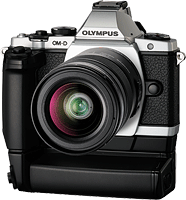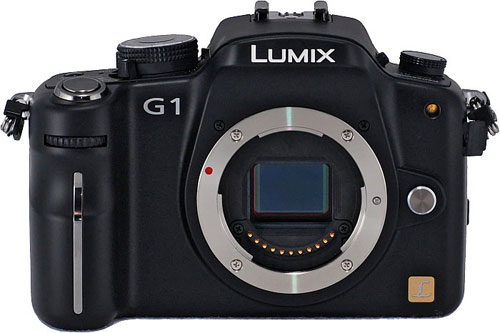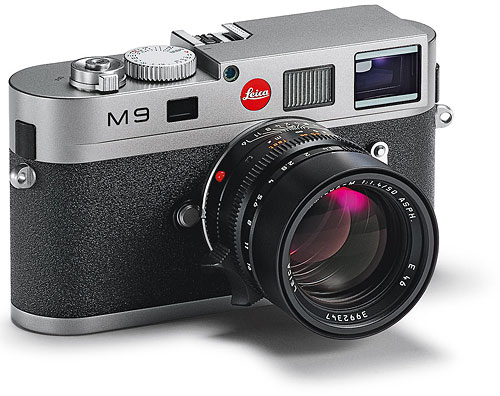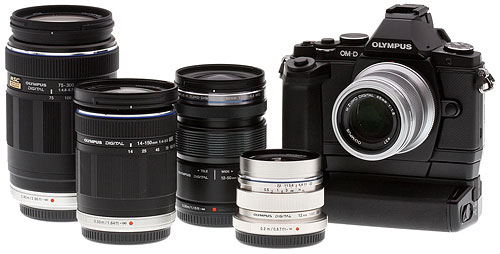The Rashomon Effect and My Small-Camera Choice
posted Monday, June 11, 2012 at 12:36 PM EDT
 Monty Python’s Quest for the Small Camera Grail
Monty Python’s Quest for the Small Camera Grail
Way back in the day, when the first mirrorless cameras were released, I was on them like white on rice. I desperately wanted to love, well, any of them: The Sigma DP1, Panasonic G1, Olympus P1, Leica X1, and more all passed through my hands. Many people loved having a small camera that delivered high image quality. I loved that idea, too, but I didn’t love those first cameras because of what they couldn’t do. They couldn’t shoot high ISO. There weren’t many lenses. Autofocus times reminded me of loading pages on dial-up internet connections. But at the time (way back in 2009), I thought that this was the future of consumer imaging. I predicted that by their third generation, mirrorless cameras would eventually take over the intro-level SLR slot.
Two full years have passed. Second-generation technology and many more lenses were released. And this year a LOT of new, smaller cameras came out. Many were now third generation for their companies. Others were from new companies with new ideas. So I paid a lot more attention as the cameras rolled out this time. I even influenced the-keeper-of-the-purse to buy into several new smaller camera lines. (Which largely consisted of me promising that these would be different than all those X1, X100, and DP1 bodies that never rented).
This time, I was going to have a lot of options to choose from. And this wasn’t just me forming an opinion for Lensrentals; it was time for me to buy a new personal camera. Like every other Lensrentals employee I can take equipment home when it’s available. But in the summer months, what I want often isn’t available when I want it. Last week Tim and I were circling a single Olympus OM-D like a couple of buzzards looking at fresh roadkill. Tim played the “I have to write the take on it so I need to have it this weekend” card. Four other people were drawing straws for the only Canon 70-200 f/2.8 left on the shelf. So I planned on two purchases this summer: a new SLR (next blog post for that), and a new small camera.
With that in mind, as every new small camera has been released I’ve tested it, taken it home for a weekend’s shooting, in some cases even taken it apart, or Imatested the available lenses for it. I was going to decide which small camera was The Best and tell you all about why this was so. But the more I tested the current systems, the more I decided I wouldn’t have anything to tell anyone about which mirrorless camera THEY should get. The more I looked into these cameras, the more I concluded that the Rashomon Effect was going to be far more important than any tables and lists I could make about camera features and flaws.
|
Panasonic's Lumix DMC-G1 was the first mirrorless model to hit the market. Photo copyright © 2008, Imaging Resource. All rights reserved. |
The Rashomon Effect
The Rashomon effect is named from a superb 1950′s movie in which 4 characters all witness the same event, yet each has very different, but equally plausible, opinions about what happened. The phenomenon is very real and studied in fields such as psychology and criminology. There are a lot of reasons why people have such different opinions when given the same facts. Most of the difference is because the observers are different--they have varied backgrounds, knowledge, and expectations.
I’ll give you an example. When asked what the best restaurant in my area is, I have an immediate answer, there’s one that I simply love and we go there every week. The food is good, the service is quick, and it’s casual enough that we don’t need to get dressed up. I told some of my friends about it and their opinions were totally different. My first friend said he liked the food and service, but it was really overpriced for a casual place. The second thought the food was average at best and he wouldn’t go back. The third took a date there and thought it was rushed and crowded.
Now if restaurant discussions were online photography forums, the four of us would have a 90-post thread where each of us called the other three idiots who didn’t have any eating skills. But since we are real people having real discussions, it quickly became apparent why we had such different opinions. I generally eat breakfast and lunch at my desk, and won’t go out to dinner if it’s going to take more than an hour because I do my writing after work and on weekends. I hate to dress up for any occasion, and when we do go out we have a 10 year old to entertain and despite an iPad and Game Boy he’s not going to sit through a 4 course meal. My favorite restaurant’s fast service and casual atmosphere were all great things, and the food was superb when compared to my usual Pizza Hut cuisine.
But my first friend is just starting a family. Money is tight and when he and his wife get to go out, it’s a big deal involving a baby sitter. Pricey, quick, and casual just doesn’t make it for him for their rare date night. My second friend is a gourmet and eats out at least 3 or 4 nights a week. What is great food to me was boring and plain to him. For my third friend, the lack of ambiance was a killer--his priorities were about the eventual outcome of his date, not about getting good food quickly.
Just as the Rashomon Effect made my opinion about restaurants completely different from theirs, it was probably going to make my opinion about small cameras completely different from yours. So instead of telling you which small camera is The Best, I’ll just tell you about my own decision making process in choosing the one that was right for me. The truth is most of the current mirrorless cameras are really quite good, though, and what was right for me may well not be the best choice for you.
|
Roger ruled out the Leica M9 due to its size and a personal preference against rangefinders. Photo provided by Leica. |
What I Wanted in a Small Camera
On my small camera wish list I have four absolute priorities. Small is my first priority (my definition of small is “fits in my wife’s purse”). It also absolutely must have a viewfinder. I live in the South; the sun can glare out any LCD screen made, leaving me shooting blind if there’s no viewfinder. My third priority is that it must have a range of available focal lengths. I loved the Fuji X100, but over time realized that I couldn’t stand having only one focal length available. My final absolute priority has to do with my inability to focus a rangefinder camera. Because I have eye problems. I just can’t do it.
My absolute criteria, then, ruled out the Leica M9 and X2, Fuji X100, Panasonic GF3, Sigma DP2x, and Nikon J1. The Fuji X-Pro1, Panasonic GH2, and Canon G1 X weren’t completely ruled out, but all were a bit bigger than I hoped for, so they certainly had a strike against them. The G1 X does have a viewfinder, but an awful one, so I ruled it out because of its combination of large size and bad viewfinder. All of the above are pretty good cameras. They just don’t fit my particular requirements.
Next it was time to move on to my preferences. My strongest preference was a good autofocus system with native-mount, autofocus lenses. At the same time, I would like to shoot some manual focus lenses--M mount lenses on an adapter--if the camera had an excellent MF assist system. (I preferred a peaking filter like the Sony NEX cameras, but would consider a good focus magnification system on a clear, high-resolution EVF.) While not absolute rule-outs, this criterion dropped the Fuji X-Pro1 on my list. (I realize there’s a rule that every camera product made from 2010 forward has to have an X in the name, but I’m not sure of the wisdom of naming a mirrorless camera “ex-pro”. Is that who they expect to shoot it? Old photographers who used to be pros?)
You’re probably screaming “what about image quality?”, right about now. That’s one area where the Rashomon Effect is probably going to differentiate me from most people. I know that 95% of the time the images from my small camera go nowhere, other than online jpgs or my wife’s Facebook page. When I do print, though, I print large (16x20 and up). The sensors in the Sony NEX, Fuji X-Pro1, Samsung NX20, and the 16-megapixel Micro Four Thirds cameras could certainly make 16x20 prints at near 300 DPI. There was still some question as to whether the lenses you put in front of all of those resolved well enough to make that print as sharp as I would like, which is part of my motivation for testing Micro Four Thirds and Sony E-mount lenses lately. So I felt image quality would be more about the lenses than the bodies.
There was an easy winner to the lens part of my selection process: the Micro Four Thirds group has by far the best selection of good lenses in native mount. It’s not close. There are finally some good E-mount prime lenses, but Panasonic has countered that by announcing an f/2.8 fixed-aperture zoom. Both NEX and Micro Four Thirds offer me the option of shooting Leica, Zeiss, and Voigtlander M mount lenses on adapters, which is a nice plus for me. Sony’s peaking filter makes manual focus a dream, but the NEX-7 has issues with some of the wide-angle lenses, which complicates things a bit.
One other part, though, was a problem. I shoot medium telephoto images--a 35mm equivalent of 150-300mm. That range is a huge weakness for all mirrorless systems right now. I know some of you will disagree with my assessment of Micro Four Thirds and Sony telephoto lenses. Which brings us back to the Rashomon Effect. In this case, maybe I’m the gourmet diner who finds the food just not good enough. I’ve shot with excellent telephoto lenses and to me Panasonic 100-300, Olympus 75-300, Sony 18-200 and 55-210, etc. are just barely adequate. And no, I have no desire to put a three-pound lens on an adapter and attach it to my pocket camera. If I’m going to take a big lens with me, then I might as well take a big-boy camera, too.
|
For Roger, the Olympus O-MD E-M5 fit the bill nicely. Photo copyright © 2012, Imaging Resource. All rights reserved. |
What I Decided
First and foremost, I decided I’d been wrong two years ago when I said, “the third generation of mirrorless cameras will largely replace starter SLRs”. We’re close, and I still believe this to be inevitable, but we're not quite there yet. Largely that’s because the lens selection isn’t there yet, even though it’s getting better quickly. I still feel the takeover is inevitable, though.
Early in my decision making process I ruled out a couple of cameras. I really liked the Fuji X-Pro1, its lenses, and its roadmap. But the AF system isn’t what I hoped for, and it looks like it may be the X-Pro2 before that gets fixed. Given its higher price, the X-Pro1 would have to be better than the competition for me to consider it. It isn’t, so I didn’t and the X-Pro1 was eliminated. Everything I’ve read about the Pentax K-01 says it’s excellent, too, but LensRentals doesn’t stock Pentax, so I didn’t try it either.
I was very impressed with the Samsung NX20. I expect everyone will steal their integrated Wi-Fi setup. It’s the first one I’ve ever been able to use consistently. Samsung has a decent lens selection and a large, 20-megapixel sensor that is quite good. Finally, it has a really good EVF and a high quality LCD. The more I use this little guy, the more I like it. The biggest hold off, for me, is the lack of high quality adapters for Leica lenses (only a matter of time, I know, but I’m impatient). That would be an issue for very few people, though, and this camera probably deserves more consideration than it generally gets.
Of the Micro Four Thirds cameras, the Olympus OM-D was my favorite. It’s full-featured, the autofocus is amazingly fast and accurate, it fits my hands comfortably, and just does everything efficiently and well. I will add, though, if I shot video, I may have gone with the Panasonic GH-2, even though it’s larger size was not appealing to me. Finally, if money were the primary consideration, I’d say the Panasonic G3 is an amazing bargain for $500.
Of the NEX cameras, whether I went with the NEX-7 or the NEX-5N would have been a coin flip. When you add the EVF to the NEX-5N, cost is similar. I always likes me some extra megapixels, but there are a lot of reports which suggest that the NEX-5N actually does some things better than the NEX-7. The tilting LCD screen is a real positive to me, too.
I’d really prefer the APS-C sensor size, all other things being equal, and I love the peaking filter, but in the end I chose the Olympus OM-D over the Sony NEX. The images are still good enough to make a large print, and when I want to play narrow-depth-of-field, I’ll be shooting an SLR. Despite no peaking filter, I found both the viewfinder and LCD on the Olympus let me manually focus with good accuracy. I really liked the camera, but not for any “it’s clearly better” reasons. I just found it intuitive and easy to use.
The biggest reason for my choice, though, is one that I suspect will apply to very few people other than me (and therefore my choice will be a good example of the Rashomon Effect). I discovered that I could get really good telephoto images on either the Micro Four Thirds or NEX systems by shooting Leica 90mm f/2.8 and 135mm f/3.4 Telyt lenses. The images were far better than I could get with any of the native-mount telephoto lenses and the lenses themselves are quite small, which is important to me when working with a small camera. The Olympus provides in-camera image stabilization with these lenses, allowing me to shoot them hand-held even if the light isn’t great. That was one of the major reasons for my choice.
So for me, the choice of which mirrorless camera ended up being quite simple. If someone else had done all of the same evaluations that I did, they probably would have made a different choice. We all have different shooting styles and different priorities. If I didn’t shoot telephoto; if I had a single favorite focal length that I did most of my shooting at; if I was moving up from a point and shoot rather than down from an SLR, any of several other cameras would have met my needs.
(Roger Cicala is the founder of LensRentals.com. Visit LensRentals.com to check out that cool lens you've been hankering for, and for some of the best customer service on the Internet!)



